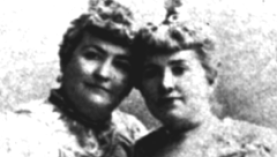
Elizabeth Bangs (1859–1920) and Mary Bangs (1862–1917) were controversial spirit mediums noted in particular for producing ‘spirit portraits’. Numerous detailed allegations of fraud were made against them.
Elizabeth (Lizzie) Snow Bangs and Mary (May) E Bangs were born in Atchison, Kansas. The family moved to Chicago in 1868 and by 1872 were conducting public séances at their home, noted for musical phenomena, the materialization of a cat, a ‘dancing chair’ and other ‘miracles’.1 In 1874 they were said to have experienced a poltergeist, and according to their mother this was the beginning of their communication with spirits.2
Claims
Many witnesses were impressed with what they observed. In one instance, Lizzi Bangs was said to have received written spirit communications by means of a typewriter, seemingly operated without human contact, while her limbs were held by four men.3 The girls were especially noted for their production of ‘spirit portraits’, as described by W Usborne Moore:
Two thin canvases stretched on wooden frames and covered with thin paper were placed face to face and held up in the window. The blind was drawn to the top of the canvases, and curtains were hung up in my presence on either side … May Bangs sat on my right side, facing me, and pinching together with her right hand one side of the canvases; Lizzie Bangs on my left side, facing me, and pinching together the other side of the canvases with· her left hand. I faced the middle of the canvases … After a few minutes the canvas assumed various hues, rosy, blue, and brown; it would become dark and light independently of the sun being clouded or not. Dim outlines of faces occasionally appeared in different parts of the canvas … We had been sitting forty minutes when the right and left edges of the canvas began to darken, and the face and bust suddenly appeared. It was finished in thirty-five minutes i.e. one hour and fifteen minutes from the time we first sat down.4
Moore stated that he was ‘confident that no fraud was practiced on me by these sisters’5 and he criticized sceptics who accused them of faking.
Further descriptions of the sisters’ ‘powers’ and methods of operation were commended by the writer and spirit photographer James Coates in his book Photographing the Invisible.6 Emma Hardinge Britten reported that several persons of undoubted credit had testified seeing ‘invisible presences’ in the Bangs’s house in daylight conditions.7
Fraud
Numerous detailed fraud allegations were made against the Bangs family. Newspapers reported court appearances and trouble with the police for giving ‘unlicensed shows’ in 1881.8
In 1888 John Curtis Bundy published a detailed exposure in the Religio-Philosophical Journal, concluding that ‘[t]heir moral obliquity is something shocking. In all my experience I never saw it surpassed and seldom equalled …’9 A Protestant minister, Stanley L Krebs, described in detail how he had covertly used a small mirror to observe the means by which the sisters pretended to receive written ‘spirit messages’.10 Further details of trick methods attributed to the sisters were published by SPR researchers Richard Hodgson11 and Hereward Carrington12 and by David P Abbot, a stage magician.13
Portraits Collection
A collection of portraits produced by the Bangs sisters is maintained at the Spiritualist Camp at Chesterfield, Indiana.14
Literature
Abbot, D.P. (1913). The Spirit Portrait Mystery. Chicago, Illinois, USA: The Open Court Publishing Co.
Atchison Daily Globe (1881, Aug. 23 & 24).
Britten, E. H. (1883). Nineteenth Century Miracles or Spirits and Their Work in Every Country on Earth. Manchester, UK: William Britten.
Bundy, J.C. (1888). The Bangs sisters exposed. Religio-Philosophical Journal (April 7).
Carrington, H. (1913). Personal Experiences in Spiritualism. London: T. Werner Laurie, Ltd.
Coates, J. (1911). Photographing the Invisible. London: L.N. Fowler & Co.
Heagerty, N. R. (2016). Portraits from Beyond. The Mediumship of the Bangs Sisters. Hove, UK: White Crow Books.
Hodgson, R. (1899). Quaestor Vitae and the Bangs sisters. Light 19/957 & 958 (May 13 & 20), 223-36.
Jones, S.S. (1872). An evening with the Bangs children. Religio-Philosophical Journal 12/20 (Aug. 3, 4).
Krebs, S.L. (1901). A description of some trick methods used by Miss Bangs of Chicago. Journal of the Society for Psychical Research 10, 5-16.
Moore, W. Usborne (1911). Glimpses of the Next State. London: Watts & Co.
Quaestor Vitae et al (1896). Type-writing without human contact. Light 16/785 (Jan. 25), 43-45.
Endnotes
- 1. Jones (1872), 4.
- 2. Heagerty (2016).
- 3. Quaestor Vitae (1896), 43.
- 4. Moore (1911), 241-42.
- 5. Moore (1911), 275.
- 6. Coates (1911), 297-316.
- 7. Britten (1883), 540-41.
- 8. Atchison Daily Globe (1881), August 23 & 24.
- 9. Bundy (1888).
- 10. Krebs (1901), 5-16.
- 11. Hodgson (1899), 223-36.
- 12. Carrington (1913), 76-94.
- 13. Abbot (1913).
- 14. https://campchesterfield.net/

